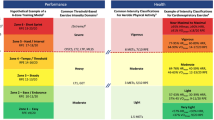Summary
With a view to investigating the aerobic and anaerobic proportions of oxygen supply during different grades of muscular activity in varying thermal stress, studies have been conducted on six young healthy Indians naturally acclimatized to heat. The subjects were given submaximal exercises of 400, 500, and 600 kgm/min (equivalent to 65.40, 81.75, and 98.10 W) for 6 min on a bicycle ergometer in three different simulated conditions, i.e., comfortable, hot humid, and very hot humid. Their O2 consumption (VO2), pulmonary ventilation (V E) and heart rate (HR) were measured during rest and throughout the exercise period (6 min) and for 30 min post exercise. Blood lactate level (LA) was measured during rest and recovery. From these, the total O2 cost with aerobic and anaerobic proportions were calculated. Results indicated a significant increase in the total O2 cost for each exercise with increasing thermal stress, along with a significant increase in the anaerobic fraction and a decrease in the aerobic fraction. The increase in anaerobic contribution to the energy supply processes was further confirmed by a significant increase in relative O2 debt (l/kg) and in blood lactate level at each work load. Thus, a highly significant correlation (P<0.001) was found between O2 debt contracted and increase in thermal stress. A significant fall in VO2 max was also observed in hot humid and very hot humid conditions as against comfortable temperature, with no change in HR max and V E max.
Similar content being viewed by others
Change history
01 April 1981
An Erratum to this paper has been published: https://doi.org/10.1007/BF00422175
References
Alexander SC, Workman RD, Lambertson G (1962) Hyperthermia, lactic acid infusion, and the composition of arterial blood and cerebrospinal fluid. Am J Physiol 202: 1049–1054
Barker SB, Summerson WH (1941) The colorometric determination of lactic acid in biological material. J Biol Chem 138: 535–554
Bean WB, Eichna LW (1943) Performance in relation to environmental temperature. Fed Proc 22: 144–158
Brooks GA, Hittleman KJ, Faulkner JA, Beyer RE (1971) Temperature, skeletal muscle mitochondrial function, and oxygen debt. Am J Physiol 220: 1053–1059
Brouha L, Smith PE Jr, de Lanne R, Maxfield ME (1961) Physiological reaction of men and women during muscular activity and recovery in various environments. J Appl Physiol 16: 133–140
Claremont AD, Nagle F, Reddan WD, Brooks GA (1975) Comparison of metabolic, temperature, heart rate, and ventilatory responses to exercise at extreme ambient temperatures. Med Sci Sports 2: 150–154
Consolazio CF, Matoush LRO, Nelson RA, Torres JE, Issac GJ (1963) Environmental temperature and energy expenditure. J Appl Physiol 18: 65–68
Dill DB, Edwards HT, Bauer PS, Levenson EJ (1931) Physical performance in relation to external temperature. Arbeitsphysiologie 4: 508–518
Eichna LW, Park GR, Nelson W, Horvath SM, Palmer ED (1950) Thermal regulation during acclimatization in hot dry (desert type) environment. Am J Physiol 168: 685–697
Kaufmann W, Mary HH, Seimon G, Schlitter JG (1963) Respiratory metabolism and blood gases under exogenous heat load. Med Welt 52: 2693–2699
Klausen K, Dill DB, Philips EE Jr, McGregor D (1967) Metabolic reactions to work in the desert. J Appl Physiol 22: 292–296
Petersen ES, Christensen HV (1973) Effect of body temperature on steady state ventilation and metabolism in exercises. Acta Physiol Scand 89: 342–351
Rowell LB, Blackmon JR, Martin RH, Mazzarelia JA, Bruce RA (1965) Hepatic clearance of Indocyanine green in man under thermal and exercise stresses. J Appl Physiol 20: 384–395
Schulze W, Rudenfeldt H, Ferch U (1965) Studies on the influence of high temperature and high air humidity on the body temperature, respiratory and heart frequency. Wien Tieraerztl Monatsschr 52: 436–454
Sen Gupta J, Dimri GP, Malhotra MS (1977) Metabolic responses of Indians during submaximal and maximal work in dry and humid heat. Ergonomics 20: 33–40
Strom G (1949) The influence of anoxia on lactate utilization in man after prolonged muscular work. Acta Physiol Scand 17: 440–451
Welch HG, Faulkner JA, Barclay JK, Brooks GA (1970) Ventilatory responses during recovery from muscular work and its relation with O2 debt. Med Sci Sports 2: 15–19
Wenzel HG (1963) Studies on the question of defining tolerable and intolerable heat load for man during physical work lasting several hours. Arch Ges Physiol 278: 96
Williams CG, Bredell GAG, Wyndham CH, Strydom NB, Morrison JE, Peter J, Fleming PW, Ward JS (1962) Circulatory and metabolic reactions to work in heat. J Appl Physiol 17: 625–638
Author information
Authors and Affiliations
Rights and permissions
About this article
Cite this article
Dimri, G.P., Malhotra, M.S., Sen Gupta, J. et al. Alterations in aerobic-anaerobic proportions of metabolism during work in heat. Europ. J. Appl. Physiol. 45, 43–50 (1980). https://doi.org/10.1007/BF00421200
Accepted:
Issue Date:
DOI: https://doi.org/10.1007/BF00421200




